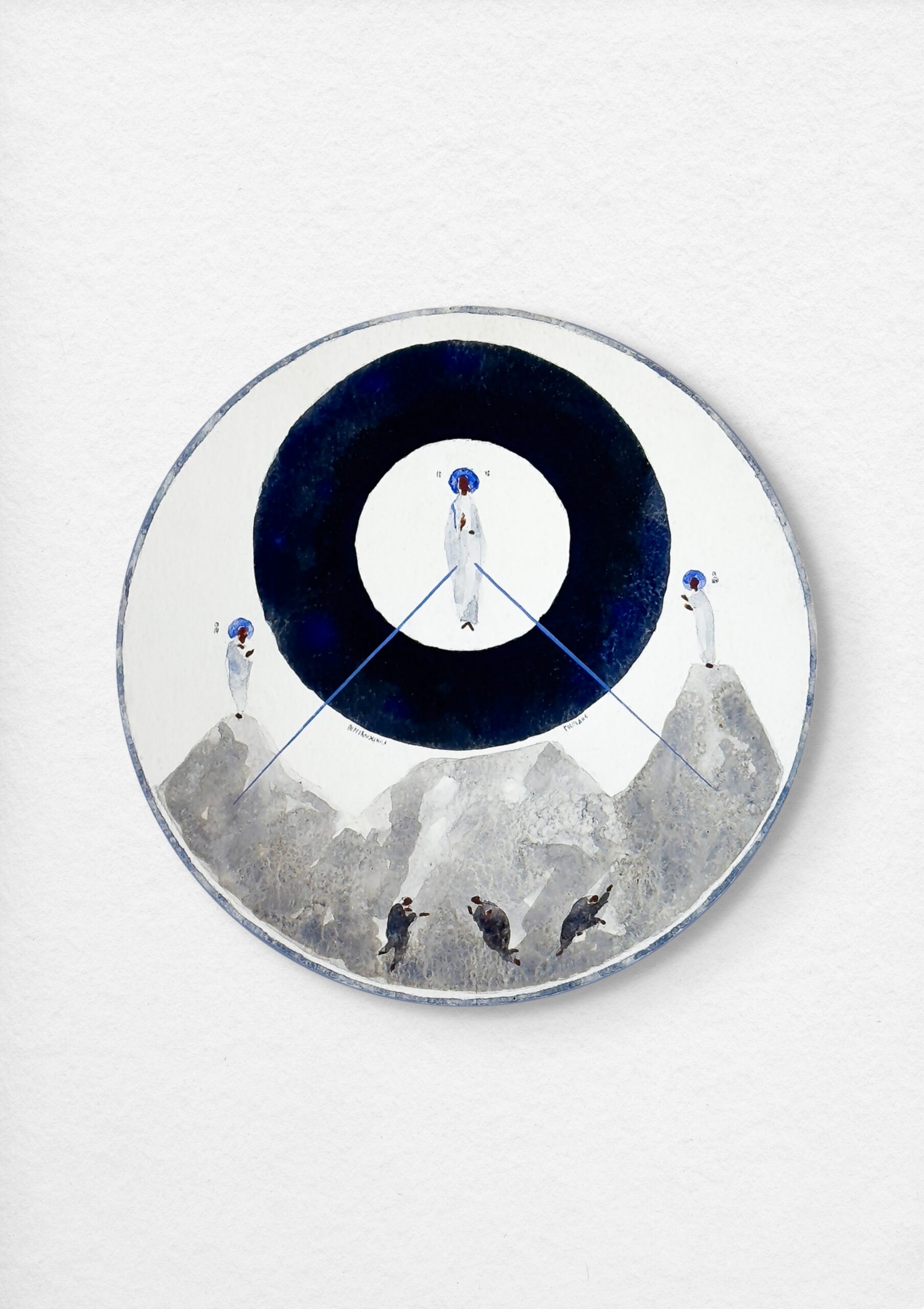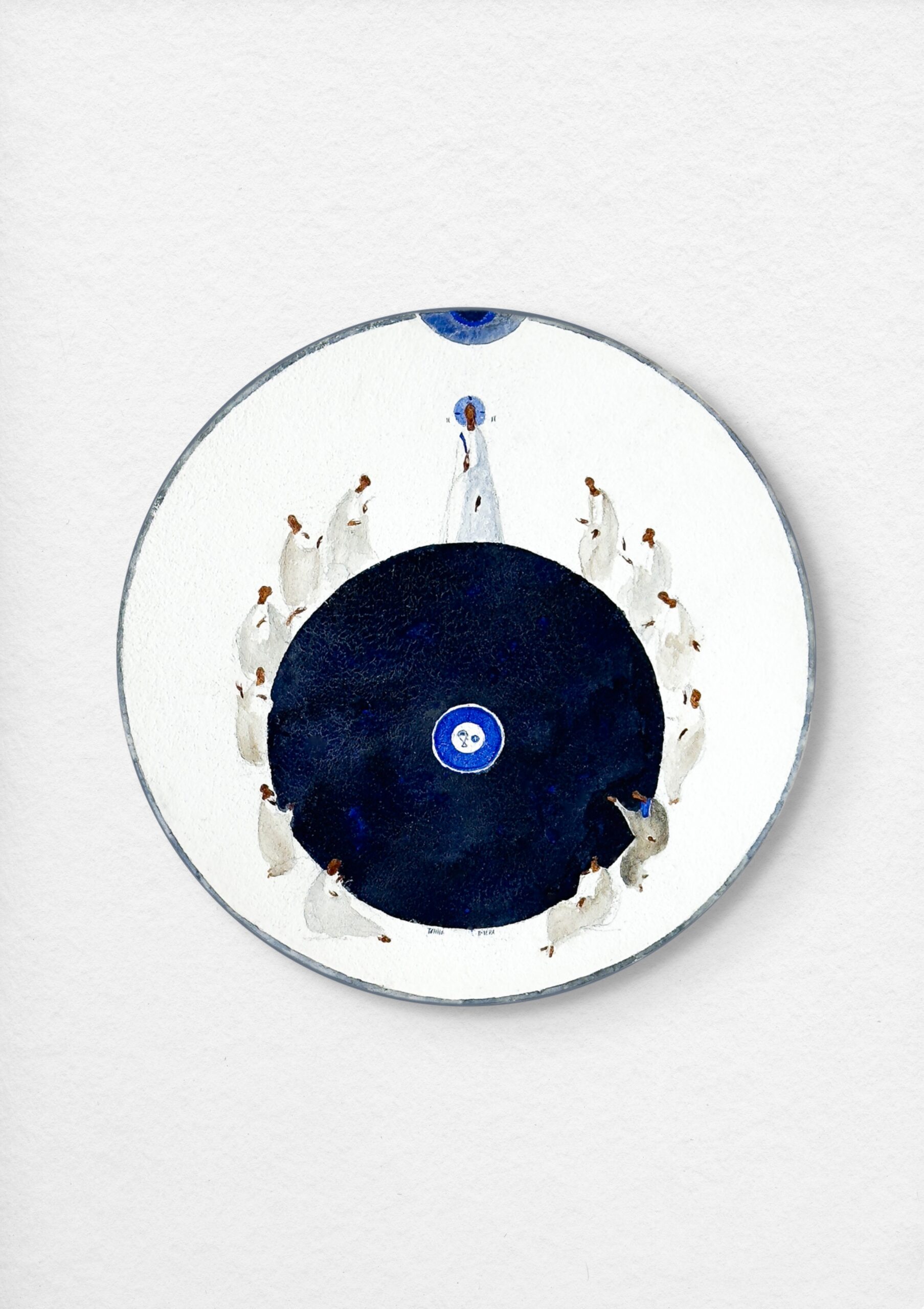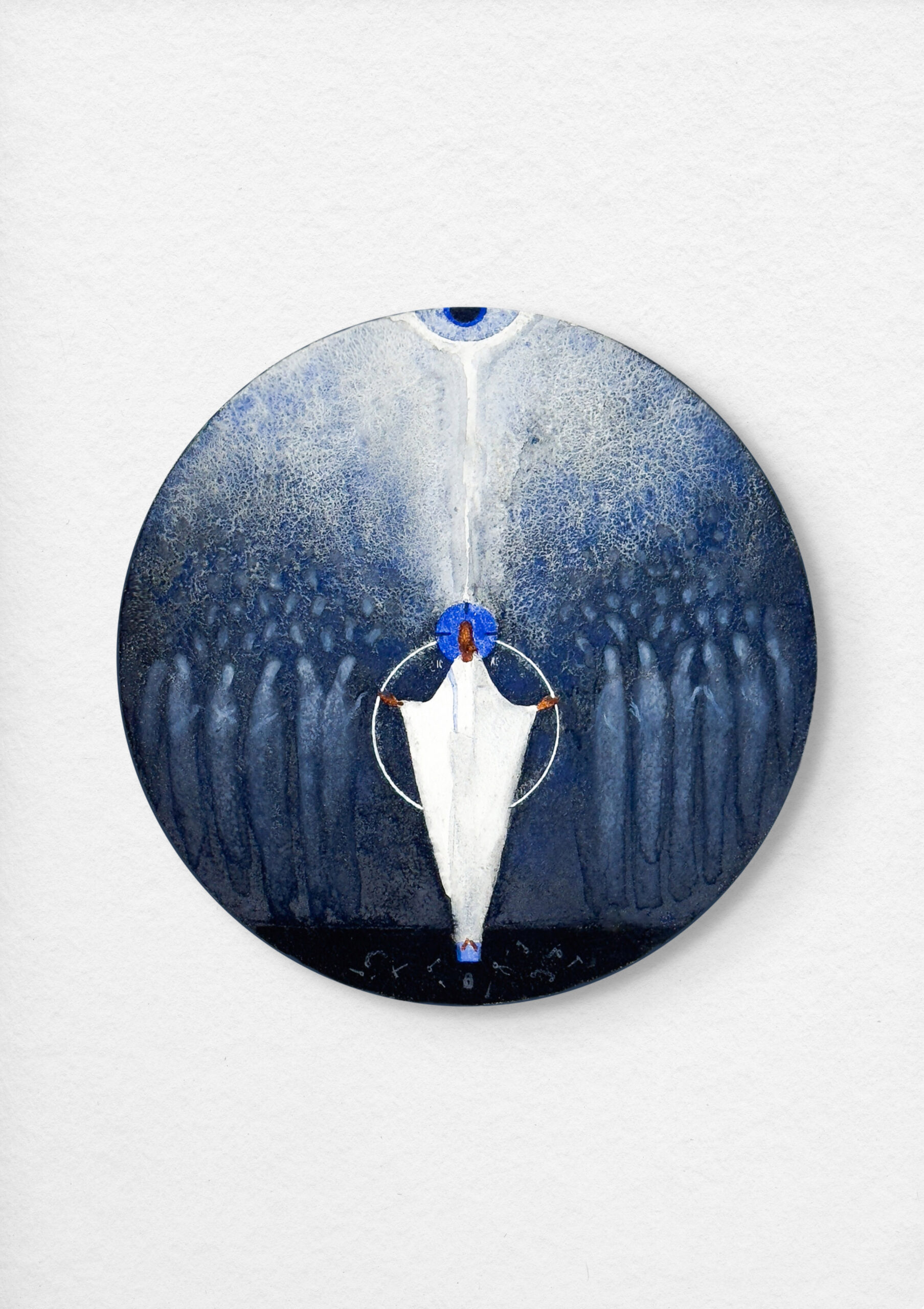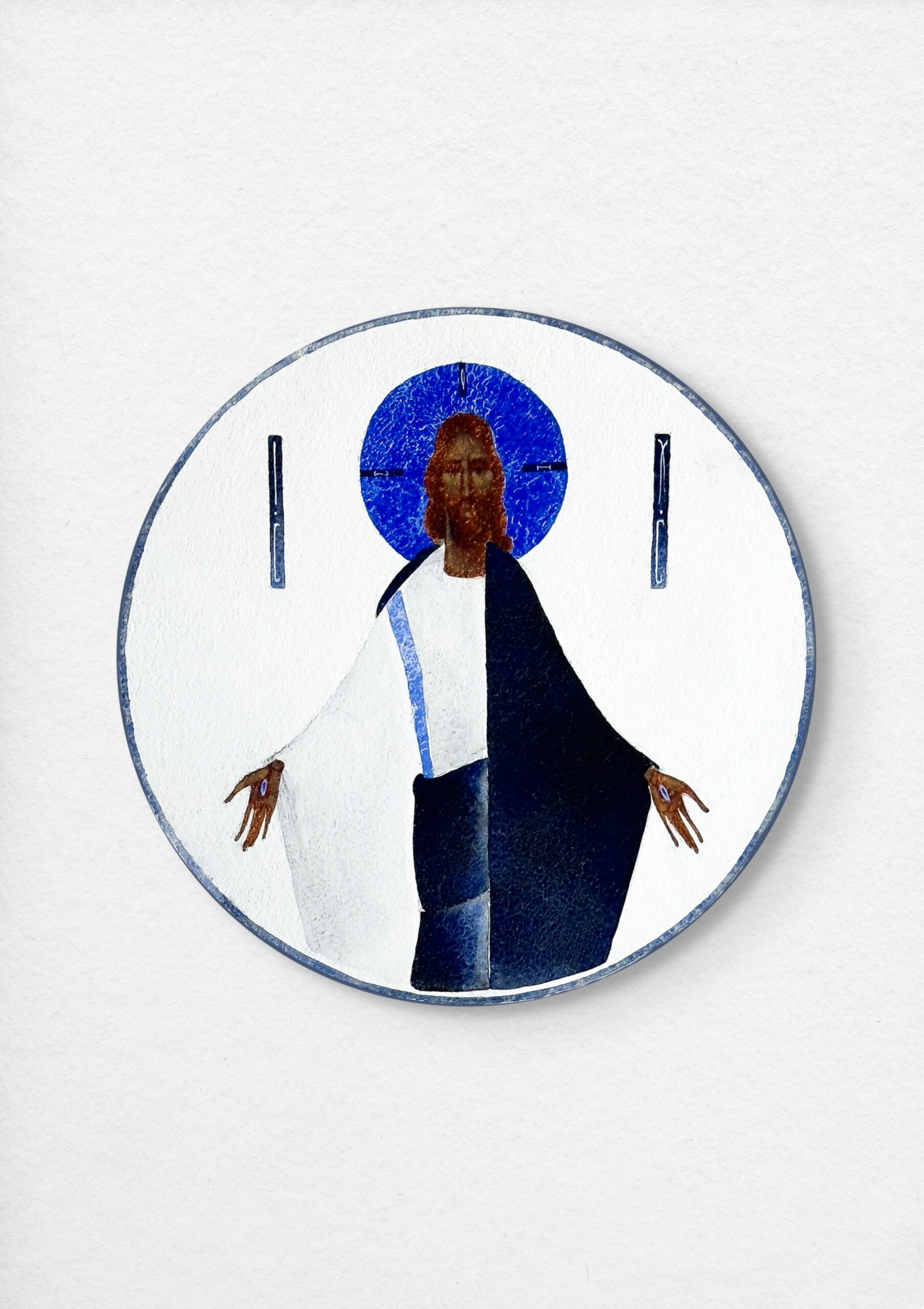
The series portrays ten significant moments in the life of Jesus Christ. In this design, the focal point is the circle. As an ideal geometric figure, recognized for centuries as a symbol of the absolute, it is, for me, an expression of the Divine in the world of form. Saturated shades of blue embody stellar space. The circle is also a direct reference to the figure of Christ, his cosmic dimension and the depth of human existence.
.
2017 r. | 20×20 cm | linden board | chalk-glue primer | egg tempera
.
Annunciation
“But the angel said to her, “Do not be afraid, Mary; you have found favor with God.” (Luke 1, 30)
The Archangel Gabriel came to Mary, a woman of Nazareth, to announce to her that the prophets’ promises would be fulfilled through her. She was told that her Son, whom she would conceive through the Holy Spirit, would be the Son of God Himself. Mary and Gabriel engage in dialogue without words, using only glances and gestures. The Mother of God weaves a veil for the Jerusalem temple; which will tear when Christ dies on the cross.
.
.
Birth
„But the angel said to them, “Do not be afraid. I bring you good news that will cause great joy for all the people. Today in the town of David a Savior has been born to you; he is the Messiah, the Lord.” (Luke 2, 10-11).
The central element of the icon is a mountain with an open cave, symbolizing the earth and the fall of man. In the background, Christ is depicted in a tomb-like manger, wrapped in diapers like a burial shroud. Mary is depicted lying in confinement. Joseph sits distant, haggard with doubt. The Three Wise Men follow the star from the east. The incarnation is the greatest expression of love known to humanity. The Unlimited descends to Earth to confine itself in its human form.
.
.
Baptism
„And a voice from heaven said, “This is my Son, whom I love; with him I am well pleased.” (Matthew 3:17).
When Christ descends into the waters of the Jordan River to undergo baptism, a voice from heaven is heard revealing that He is the Son of God. The descent into the ‘liquid tomb’ of the Jordan precedes the descent into the Abyss, and the meaning of both acts is identical: through death, Christ saves man, and in the nakedness of his body, the new Adam is revealed. John leans on Christ, who rises above the waters and sanctifies them with his person. Through Baptism, Christ restored the original image of humanity and its beauty, which had been lost due to original sin.
.
.
Transfiguration
„There he was transfigured before them. His face shone like the sun, and his clothes became as white as the light. Just then there appeared before them Moses and Elijah, talking with Jesus.” (Matthew 17, 2-3)
The Transfiguration shows the event when Christ ascended Mount Tabor with his disciples Peter, James, and John. The mountain was a place of encounter with God and His revelation. The weary disciples beheld Moses and Elijah atop Tabor, with Christ shining between them, radiating blinding light. God incarnate was revealed to their eyes, and the experience was so intense for the human body that it caused the disciples to fear and fall.
.
.
The resurrection of Lazarus
“When he had said this, Jesus called in a loud voice, “Lazarus, come out!” The dead man came out, his hands and feet wrapped with strips of linen, and a cloth around his face. Jesus said to them, “Take off the grave clothes and let him go.” ( John 11, 43-44) (John 11, 43-44).
Lazarus came from Bethany, a town located three kilometers from Jerusalem. Together with his sisters, Martha and Mary, they often hosted Jesus at their home. Lazarus became ill and died while Christ was on the other side of the Jordan River. The dynamic of the icon is based on the gesture of Jesus, who frees Lazarus from death with his outstretched right hand. Lazarus’ sisters make a deep bow before Jesus. The resurrection of Lazarus is a foreshadowing of the Resurrection of Christ Himself.
.
.
Last Supper
„And he took bread, gave thanks and broke it, and gave it to them, saying, “This is my body given for you; do this in remembrance of me.” In the same way, after the supper he took the cup, saying, “This cup is the new covenant in my blood, which is poured out for you.” ( Luke 22, 19-20).
The icon represents the event of the last supper of Christ and his disciples. It is both the moment of the establishment of the Eucharist and the future priesthood. Jesus also indicates the person who will betray him. Judas, after eating a piece of bread, departs “into darkness.” The bread and wine symbolize the upcoming sacrifice of the Body and Blood, soon to be accomplished on the cross for the salvation of all of us.
.
.
Crucifixion
“At noon, darkness came over the whole land until three in the afternoon. 34 And at three in the afternoon Jesus cried out in a loud voice, “Eloi, Eloi, lema sabachthani?” (which means “My God, my God, why have you forsaken me?”) (Mark 15, 33-34).
Christ was crucified on Friday, on top of a mountain called Golgotha, which means “place of the skull.” In the Basilica of the Holy Sepulchre in Jerusalem, there is the Chapel of Adam where a visible crack in the rock is believed to be a trace of the earthquake that followed Jesus’ death. According to legend, this is where Adam’s skull was supposed to be buried. Christ is the new Adam, and the cross is the tree of eternal life. From now on, no man dies alone, Christ dies with him to call him to the resurrection together with himself.
.
.
Descent into the Abyss
“The King of Glory in His majesty trampled Death, seized the prince of Satan, handed him over to the power of Hell, and drew Adam into His brightness. “
The term describes the events in time perspective, taking place between the death and resurrection of Jesus. Behold, God Himself appears there, in the place of greatest distance from God, to lead people out of it to God. The iconography depicts the moment when Christ tramples the gates of the Abyss and pulls Adam and Eve and all the righteous of the Old Testament out of the darkness.
.
.
Doubting Thomas
“„Now Thomas (also known as Didymus[a]), one of the Twelve, was not with the disciples when Jesus came. So the other disciples told him, “We have seen the Lord!” But he said to them, “Unless I see the nail marks in his hands and put my finger where the nails were, and put my hand into his side, I will not believe.” A week later his disciples were in the house again,[domu] and Thomas was with them. Though the doors were locked, Jesus came and stood among them and said, “Peace be with you!” Then he said to Thomas, “Put your finger here; see my hands. Reach out your hand and put it into my side. Stop doubting and believe.” Thomas said to him,[ją] “My Lord and my God!” Then Jesus told him, “Because you have seen me, you have believed; blessed are those who have not seen and yet have believed.” (John 20, 24-29)
.
.
Pentecost
„Suddenly a sound like the blowing of a violent wind came from heaven and filled the whole house where they were sitting. They saw what seemed to be tongues of fire that separated and came to rest on each of them. All of them were filled with the Holy Spirit and began to speak in other tongues[a] as the Spirit enabled them.” (Acts 2, 2-4)
The Holy Spirit, given to man in God’s breath at the moment of creation, is restored to him at Pentecost. God’s energy, in the form of tongues of fire, divinizes, permeates and, with its truth, ignites human nature. At the bottom of the icon is the figure of the old cosmos king, a world in darkness, waiting to be revived by the Holy Spirit. In his hands he holds a cloth in which lie twelve scrolls – a symbol of the apostles who will embark on a journey around the world to spread the truth and teach about Christ.
.
.
.












